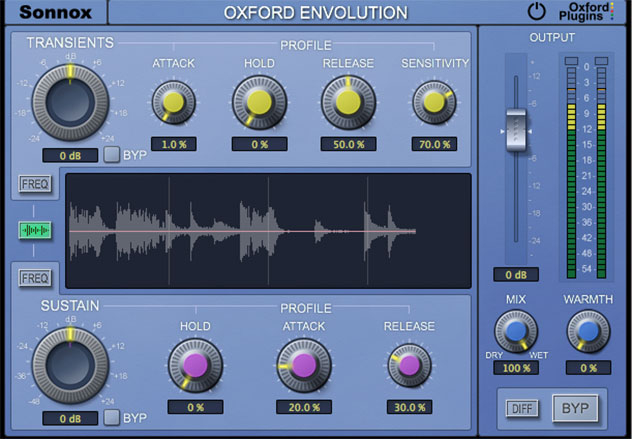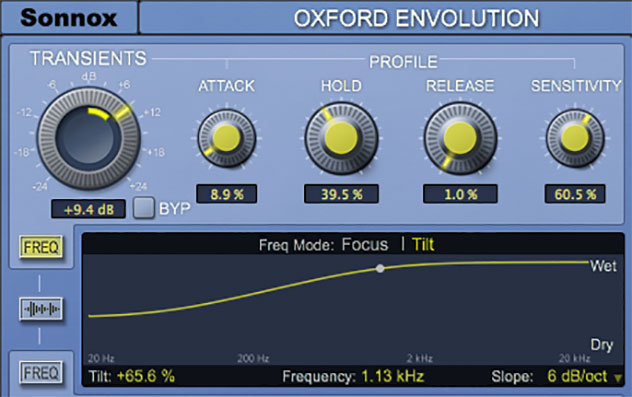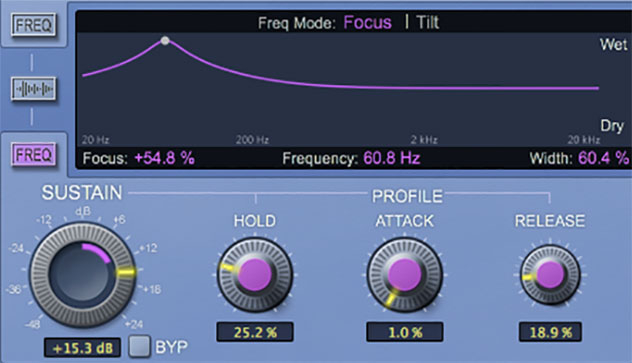- Within synthesisers, envelopes let you shape particular aspects of a sound over time. If you want a sound which peaks immediately before quickly fading to silence, you can route an envelope's attack and decay times to the synth's amplifier section. Similarly, you might route envelopes to the oscillator and filter sections to control the shape of pitch and tone modulation.
This is easy with a synth, but making similar modifications to audio files isn't. Hence the popularity of plug-ins known as transient designers. SPL has a well-known model that lets you sharpen or soften the attack response of the transients detected in a sound. You can also boost or cut the sustain portion, effectively adding or decreasing level and definition within these two key components of any incoming audio file. Sonnox has entered this market with Oxford Envolution, a plug-in whose remit is considerably broader than its competitors'. The processor is available natively across the usual plug-in formats and it's already been ported to the UAD platform too, and that's the version reviewed here.
 The central section of the interface provides a real-time display of the incoming audio signal, with colour-coded sections providing control over the detected Attack (in yellow) and Sustain portions (in pink). Starting with Attack, gain can be added to or removed from initial transients using the dial to the left, with up to 24dB of control in either direction. Then you've got the envelope shaping tools, with Attack, Hold and Release times allowing you to shape the transients by prolonging and enhancing or decreasing and reducing their effect. The Sensitivity dial in the upper right-hand corner controls how the Envolution responds to smaller transient spikes. As you crank the dial upwards, smaller transient detections become magnified and increased in intensity. As you might expect, this can inflate signals towards creative distortion territory, though be warned that things can get out of hand if pushed too hard.
A similar set of controls are found in the Sustain section below the central waveform display. As with the Transient section, you can bypass this part of the processor altogether. The Output section on the right-hand side provides a main slider for overall output level control, while the Mix dial facilitates instant parallel processing of the Envolution's signal. The Warmth dial pushes the Envolution into new territory, offering harmonic saturation of the input signal to create anything from analogue-style processing to light saturation and distortion effects. Below these controls, you'll find an effects Bypass button and a "Diff" switch, which solos the effect, so you can hear exactly what Envolution's processing engine is doing to your sound.
In addition to the comprehensive control supplied in the Transient and Sustain sections, there's another killer feature that sets Envolution apart from the competition. Both the Transient and Sustain sections can operate in a frequency-dependent manner, so that rather than evenly processing the entire frequency spectrum, an EQ curve lets you tailor the frequencies you want to change. There are two frequency modes for each section, called Focus and Tilt.
The central section of the interface provides a real-time display of the incoming audio signal, with colour-coded sections providing control over the detected Attack (in yellow) and Sustain portions (in pink). Starting with Attack, gain can be added to or removed from initial transients using the dial to the left, with up to 24dB of control in either direction. Then you've got the envelope shaping tools, with Attack, Hold and Release times allowing you to shape the transients by prolonging and enhancing or decreasing and reducing their effect. The Sensitivity dial in the upper right-hand corner controls how the Envolution responds to smaller transient spikes. As you crank the dial upwards, smaller transient detections become magnified and increased in intensity. As you might expect, this can inflate signals towards creative distortion territory, though be warned that things can get out of hand if pushed too hard.
A similar set of controls are found in the Sustain section below the central waveform display. As with the Transient section, you can bypass this part of the processor altogether. The Output section on the right-hand side provides a main slider for overall output level control, while the Mix dial facilitates instant parallel processing of the Envolution's signal. The Warmth dial pushes the Envolution into new territory, offering harmonic saturation of the input signal to create anything from analogue-style processing to light saturation and distortion effects. Below these controls, you'll find an effects Bypass button and a "Diff" switch, which solos the effect, so you can hear exactly what Envolution's processing engine is doing to your sound.
In addition to the comprehensive control supplied in the Transient and Sustain sections, there's another killer feature that sets Envolution apart from the competition. Both the Transient and Sustain sections can operate in a frequency-dependent manner, so that rather than evenly processing the entire frequency spectrum, an EQ curve lets you tailor the frequencies you want to change. There are two frequency modes for each section, called Focus and Tilt.

 Focus provides a parametric-style EQ that allows you to find a central frequency, set its bandwidth and a "Focus" amount, which progressively highlights the chosen band over the rest of the incoming frequency content. Alternatively, Tilt mode offers a low- or high-pass shelf band to strip away frequencies at either end of the spectrum. To be clear, Envolution isn't an EQ. The tone-shaping is used in tandem with the transient design element to enhance or minimise the tonal footprint of a sound before envelope shaping takes place. The central display shows the yellow and pink lines of the Transient and Sustain portions super-imposed on top of the waveform—seeing how the two lines interact with each other provides a useful piece of visual feedback.
Focus provides a parametric-style EQ that allows you to find a central frequency, set its bandwidth and a "Focus" amount, which progressively highlights the chosen band over the rest of the incoming frequency content. Alternatively, Tilt mode offers a low- or high-pass shelf band to strip away frequencies at either end of the spectrum. To be clear, Envolution isn't an EQ. The tone-shaping is used in tandem with the transient design element to enhance or minimise the tonal footprint of a sound before envelope shaping takes place. The central display shows the yellow and pink lines of the Transient and Sustain portions super-imposed on top of the waveform—seeing how the two lines interact with each other provides a useful piece of visual feedback.
 So how is Envolution best put to use? Let's suppose you've got a great drum loop but you want to replace the kick drum, which lands on every beat. Using the Transient section, you can dramatically reduce the volume of each detected hit by introducing frequency shaping to the bottom end, effectively reducing the kick drum to allow space for a replacement. Or you might prefer the opposite approach, by retaining the heavy transients on each beat but reducing the volume of what lies in between, bringing more punch to your mix in the process. In this case, the Sustain portion would do most of the work, allowing you to pull back the volume of the audio content playing between the beats. However, this isn't just a processor for rhythmic material. It's just as good at adding punch to guitars and vocals, or softening over-inflated synth stabs and basslines.
Sonnox provide a comprehensive preset library to get you started , which will be valuable as your famliarise yourself with Envolution's capabilities. But with a set of parameters this intuitive, it won't be long before you're creating settings of your own. In a little time, you'll be staggered by the range of mix applications in which this processor can make a significant mark.
Ratings:
Sound: 4.6
Cost: 4.3
Versatility: 4.1
Ease of use: 4.4
So how is Envolution best put to use? Let's suppose you've got a great drum loop but you want to replace the kick drum, which lands on every beat. Using the Transient section, you can dramatically reduce the volume of each detected hit by introducing frequency shaping to the bottom end, effectively reducing the kick drum to allow space for a replacement. Or you might prefer the opposite approach, by retaining the heavy transients on each beat but reducing the volume of what lies in between, bringing more punch to your mix in the process. In this case, the Sustain portion would do most of the work, allowing you to pull back the volume of the audio content playing between the beats. However, this isn't just a processor for rhythmic material. It's just as good at adding punch to guitars and vocals, or softening over-inflated synth stabs and basslines.
Sonnox provide a comprehensive preset library to get you started , which will be valuable as your famliarise yourself with Envolution's capabilities. But with a set of parameters this intuitive, it won't be long before you're creating settings of your own. In a little time, you'll be staggered by the range of mix applications in which this processor can make a significant mark.
Ratings:
Sound: 4.6
Cost: 4.3
Versatility: 4.1
Ease of use: 4.4
 The central section of the interface provides a real-time display of the incoming audio signal, with colour-coded sections providing control over the detected Attack (in yellow) and Sustain portions (in pink). Starting with Attack, gain can be added to or removed from initial transients using the dial to the left, with up to 24dB of control in either direction. Then you've got the envelope shaping tools, with Attack, Hold and Release times allowing you to shape the transients by prolonging and enhancing or decreasing and reducing their effect. The Sensitivity dial in the upper right-hand corner controls how the Envolution responds to smaller transient spikes. As you crank the dial upwards, smaller transient detections become magnified and increased in intensity. As you might expect, this can inflate signals towards creative distortion territory, though be warned that things can get out of hand if pushed too hard.
A similar set of controls are found in the Sustain section below the central waveform display. As with the Transient section, you can bypass this part of the processor altogether. The Output section on the right-hand side provides a main slider for overall output level control, while the Mix dial facilitates instant parallel processing of the Envolution's signal. The Warmth dial pushes the Envolution into new territory, offering harmonic saturation of the input signal to create anything from analogue-style processing to light saturation and distortion effects. Below these controls, you'll find an effects Bypass button and a "Diff" switch, which solos the effect, so you can hear exactly what Envolution's processing engine is doing to your sound.
In addition to the comprehensive control supplied in the Transient and Sustain sections, there's another killer feature that sets Envolution apart from the competition. Both the Transient and Sustain sections can operate in a frequency-dependent manner, so that rather than evenly processing the entire frequency spectrum, an EQ curve lets you tailor the frequencies you want to change. There are two frequency modes for each section, called Focus and Tilt.
The central section of the interface provides a real-time display of the incoming audio signal, with colour-coded sections providing control over the detected Attack (in yellow) and Sustain portions (in pink). Starting with Attack, gain can be added to or removed from initial transients using the dial to the left, with up to 24dB of control in either direction. Then you've got the envelope shaping tools, with Attack, Hold and Release times allowing you to shape the transients by prolonging and enhancing or decreasing and reducing their effect. The Sensitivity dial in the upper right-hand corner controls how the Envolution responds to smaller transient spikes. As you crank the dial upwards, smaller transient detections become magnified and increased in intensity. As you might expect, this can inflate signals towards creative distortion territory, though be warned that things can get out of hand if pushed too hard.
A similar set of controls are found in the Sustain section below the central waveform display. As with the Transient section, you can bypass this part of the processor altogether. The Output section on the right-hand side provides a main slider for overall output level control, while the Mix dial facilitates instant parallel processing of the Envolution's signal. The Warmth dial pushes the Envolution into new territory, offering harmonic saturation of the input signal to create anything from analogue-style processing to light saturation and distortion effects. Below these controls, you'll find an effects Bypass button and a "Diff" switch, which solos the effect, so you can hear exactly what Envolution's processing engine is doing to your sound.
In addition to the comprehensive control supplied in the Transient and Sustain sections, there's another killer feature that sets Envolution apart from the competition. Both the Transient and Sustain sections can operate in a frequency-dependent manner, so that rather than evenly processing the entire frequency spectrum, an EQ curve lets you tailor the frequencies you want to change. There are two frequency modes for each section, called Focus and Tilt.

 Focus provides a parametric-style EQ that allows you to find a central frequency, set its bandwidth and a "Focus" amount, which progressively highlights the chosen band over the rest of the incoming frequency content. Alternatively, Tilt mode offers a low- or high-pass shelf band to strip away frequencies at either end of the spectrum. To be clear, Envolution isn't an EQ. The tone-shaping is used in tandem with the transient design element to enhance or minimise the tonal footprint of a sound before envelope shaping takes place. The central display shows the yellow and pink lines of the Transient and Sustain portions super-imposed on top of the waveform—seeing how the two lines interact with each other provides a useful piece of visual feedback.
Focus provides a parametric-style EQ that allows you to find a central frequency, set its bandwidth and a "Focus" amount, which progressively highlights the chosen band over the rest of the incoming frequency content. Alternatively, Tilt mode offers a low- or high-pass shelf band to strip away frequencies at either end of the spectrum. To be clear, Envolution isn't an EQ. The tone-shaping is used in tandem with the transient design element to enhance or minimise the tonal footprint of a sound before envelope shaping takes place. The central display shows the yellow and pink lines of the Transient and Sustain portions super-imposed on top of the waveform—seeing how the two lines interact with each other provides a useful piece of visual feedback.
 So how is Envolution best put to use? Let's suppose you've got a great drum loop but you want to replace the kick drum, which lands on every beat. Using the Transient section, you can dramatically reduce the volume of each detected hit by introducing frequency shaping to the bottom end, effectively reducing the kick drum to allow space for a replacement. Or you might prefer the opposite approach, by retaining the heavy transients on each beat but reducing the volume of what lies in between, bringing more punch to your mix in the process. In this case, the Sustain portion would do most of the work, allowing you to pull back the volume of the audio content playing between the beats. However, this isn't just a processor for rhythmic material. It's just as good at adding punch to guitars and vocals, or softening over-inflated synth stabs and basslines.
Sonnox provide a comprehensive preset library to get you started , which will be valuable as your famliarise yourself with Envolution's capabilities. But with a set of parameters this intuitive, it won't be long before you're creating settings of your own. In a little time, you'll be staggered by the range of mix applications in which this processor can make a significant mark.
Ratings:
Sound: 4.6
Cost: 4.3
Versatility: 4.1
Ease of use: 4.4
So how is Envolution best put to use? Let's suppose you've got a great drum loop but you want to replace the kick drum, which lands on every beat. Using the Transient section, you can dramatically reduce the volume of each detected hit by introducing frequency shaping to the bottom end, effectively reducing the kick drum to allow space for a replacement. Or you might prefer the opposite approach, by retaining the heavy transients on each beat but reducing the volume of what lies in between, bringing more punch to your mix in the process. In this case, the Sustain portion would do most of the work, allowing you to pull back the volume of the audio content playing between the beats. However, this isn't just a processor for rhythmic material. It's just as good at adding punch to guitars and vocals, or softening over-inflated synth stabs and basslines.
Sonnox provide a comprehensive preset library to get you started , which will be valuable as your famliarise yourself with Envolution's capabilities. But with a set of parameters this intuitive, it won't be long before you're creating settings of your own. In a little time, you'll be staggered by the range of mix applications in which this processor can make a significant mark.
Ratings:
Sound: 4.6
Cost: 4.3
Versatility: 4.1
Ease of use: 4.4